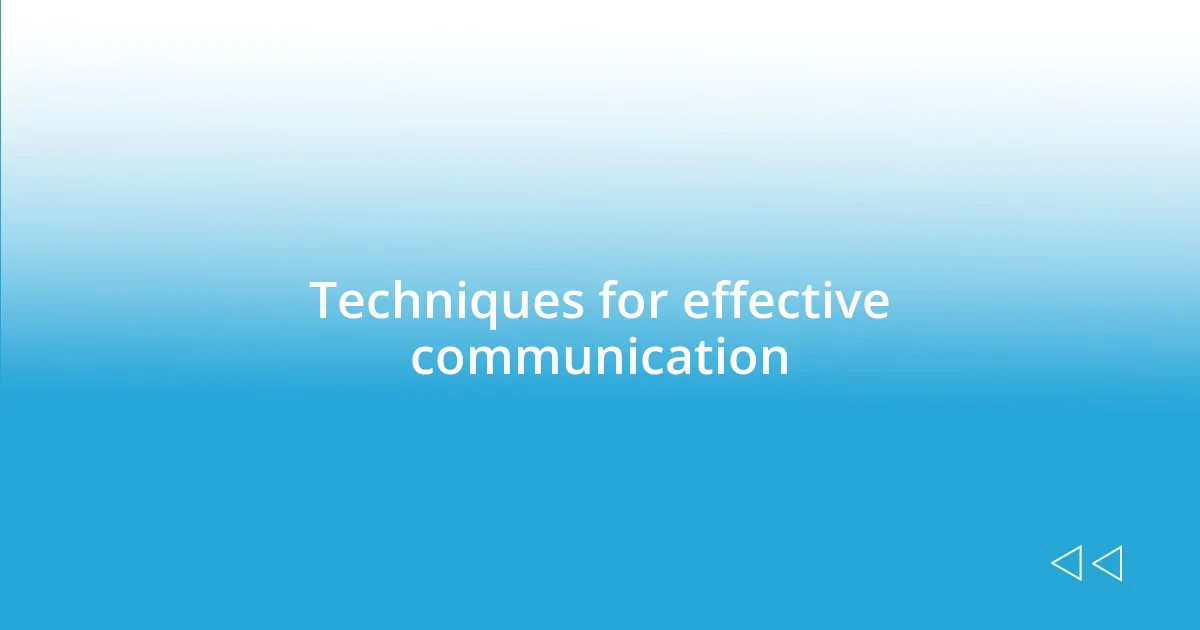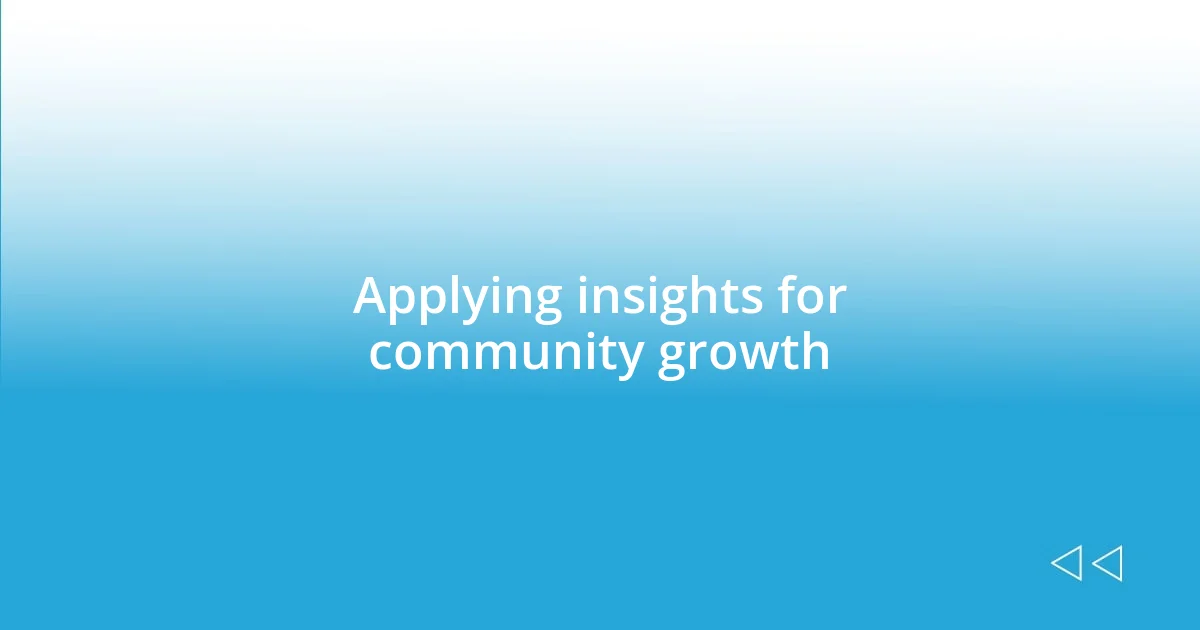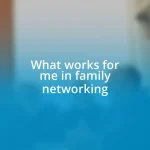Key takeaways:
- Community dialogues foster empathy and collaboration by allowing diverse perspectives to be shared, transforming conflicts into collective understanding.
- Effective communication techniques, such as active listening and open-ended questions, are essential for creating a safe environment that encourages inclusivity and participation.
- Evaluating dialogue outcomes helps translate discussions into actionable changes and highlights the ongoing process of community growth and connection.

Understanding community dialogues importance
When I first participated in community dialogues, I was struck by the sheer power of shared narratives. Each story brought to the table was a window into someone else’s reality, and it made me realize just how crucial it is to listen and learn from diverse perspectives. Have you ever felt that rush of connection when someone opens up about their experiences? Those moments taught me that understanding our neighbors’ challenges can foster empathy and lead to meaningful change.
The importance of community dialogues cannot be overstated, especially in today’s polarizing environment. I remember a particularly heated discussion in my neighborhood about local development projects; emotions were running high, and it felt impossible to find common ground. But as we each took turns sharing our thoughts and feelings, the atmosphere shifted, and unexpected alliances formed. It reminded me of how dialogue can transform conflict into collaboration.
Engaging in community dialogues is also vital for personal growth. I often reflect on how my views have evolved just from hearing the opinions of others. Have you ever had your perspective shifted simply by listening? Those moments of realization highlight that the strength of community lies not only in our similarities but also in embracing our differences through conversation. This is the essence of understanding the importance of these dialogues.

Techniques for effective communication
Effective communication is at the heart of any successful dialogue. I’ve found that active listening plays a crucial role; it’s more than just hearing words. It’s about being fully present and absorbing the emotions behind them. I remember a community event where one participant shared a deeply personal story, and by simply nodding and maintaining eye contact, I could feel the weight of their experience. Creating a space where individuals feel truly heard is transformative.
Another technique I’ve observed is the importance of open-ended questions. These questions invite deeper exploration and encourage individuals to express themselves fully. For instance, during one dialogue, I asked, “What do you think is the most significant challenge our community faces?” This sparked an engaging discussion, revealing insights that none of us had considered before. It reminded me that sometimes the best way to gain understanding is not to provide answers, but to invite more questions.
Lastly, non-verbal communication cannot be overlooked. Body language, facial expressions, and gestures communicate just as much, if not more, than words do. In a recent meeting, I noticed how the subtle shift in a person’s posture conveyed their growing openness to new ideas. It emphasized to me that effective communication goes beyond spoken language. Are we truly aware of how we present ourselves? This awareness can enhance our interactions significantly.
| Technique | Description |
|---|---|
| Active Listening | Fully engaging with the speaker, absorbing their story and emotions. |
| Open-Ended Questions | Questions that encourage elaboration and deeper discussion. |
| Non-Verbal Communication | Using body language and expressions to convey understanding and openness. |

Fostering inclusive participation
Fostering inclusive participation requires intentional efforts to ensure all voices are heard and valued. I recall a poignant moment during a community dialogue when a participant, who had always felt sidelined, finally shared their thoughts. The collective shift in energy was palpable; it was as if everyone leaned in closer, eager to understand. This taught me how fostering an inclusive environment can unleash untapped potential within our communities.
- Encouragement of Diverse Voices: Actively invite individuals from various backgrounds to share their perspectives. This may involve reaching out to marginalized groups or those less likely to engage.
- Safe Spaces: Create environments where participants feel secure to express their views without fear of judgment.
- Facilitation Techniques: Employ skilled facilitators who can manage discussions to ensure everyone has the opportunity to contribute.
- Feedback Loops: Implement methods for participants to provide feedback on the dialogue process, fostering continuous improvement in inclusivity.
It’s essential to acknowledge the barriers some individuals face, whether they stem from cultural differences or personal insecurities. I remember a time when a shy attendee was hesitant to engage. When I took a moment to invite them directly into the conversation, their face lit up, and they shared a thought that shifted the entire discussion. That experience reinforced my belief that fostering inclusive participation often means being deliberate about making space for every voice.

Identifying common community challenges
I’ve seen that identifying common challenges within a community often starts with simply listening to the stories people share. During one of our dialogues, a recurring theme emerged around access to affordable housing. As participants shared their experiences, I could see the tension and frustration in their expressions. It made me realize how vital it is to create a space where these stories can surface; they can illuminate issues that may otherwise remain hidden.
A poignant moment that struck me occurred when someone mentioned how transportation barriers impacted their ability to work or attend educational opportunities. Their voice carried a blend of anger and helplessness, which resonated with everyone in the room. It made me reflect: how often do we overlook infrastructure challenges? This encounter highlighted the importance of examining underlying issues that affect the community as a whole. Often, the most profound revelations arise when we dig deeper into what might seem like isolated grievances at first.
Moreover, I’ve learned that bringing diverse voices to the forefront can unearth challenges we may not initially recognize. I recall a discussion where a younger participant pointed out the lack of engaging recreational activities for youths. That perspective shifted the focus from economic challenges to social ones, sparking a lively debate about community engagement. It’s fascinating how sometimes the very act of sharing one’s reality can open our eyes to a web of interconnected issues. How can we begin to address these challenges if we don’t acknowledge them together?

Building trust through dialogue
Building trust in any community dialogue hinges on openness and authenticity. I remember a particular session where a participant vulnerably shared their personal struggles. The atmosphere shifted significantly; it encouraged others to speak up about their own experiences. This exchange revealed how powerful vulnerability is in fostering trust—it creates an environment where people feel seen and heard.
When participants sense genuine intent behind the conversation, trust blossoms naturally. I’ve often observed that simply acknowledging past grievances or misunderstandings can lay the groundwork for solid relationships. For instance, during one dialogue, we took a moment to address a miscommunication that had caused tension in the past. By openly discussing it, we transformed a negative into a shared understanding, reinforcing the notion that healthy dialogue can repair and strengthen community bonds.
It’s fascinating to see how trust can develop even in once-contentious environments. Reflecting on a dialogue about community safety, participants expressed their fears and frustrations. Instead of defensiveness, the facilitators focused on active listening. This approach not only validated feelings but also empowered individuals to collaborate on solutions. Capacity to share sensitive topics without fear of backlash is what turns a dialogue into a trust-building exercise. How often do we miss these vital moments of connection because we shy away from difficult conversations?

Applying insights for community growth
The insights gained from community dialogues are invaluable when it comes to fostering growth. In one lively discussion, I remember a passionate debate on local business support. A small shop owner shared how community partnerships were essential for their survival, sparking an idea among participants: why not create a monthly market to promote local entrepreneurs? This kind of brainstorming showcases how tangible solutions can arise when insights are applied creatively.
Moreover, harnessing these insights becomes an empowering tool for collective action. During a session focused on environmental concerns, I heard a resident share their frustration about litter in the local parks. Inspired by their passion, the group organized a cleanup event that not only beautified the area but also brought community members together. Reflecting on this, I can’t help but think—how often do we overlook the power of turning frustration into action? It’s remarkable how dialogue can fuel initiatives that transform not just spaces, but relationships among community members.
Lastly, it’s crucial to remember that applying these insights isn’t a one-off event; it’s an ongoing process. After discussing mental health awareness in one dialogue, we recognized the need for ongoing support groups. This realization led to continuous meetings where people could share their struggles and successes. It became clear to me that growth happens when we make a conscious effort to keep the conversation going. How might our communities thrive if we prioritized sustained engagement? The possibilities feel limitless when everyone is encouraged to contribute to the narrative.

Evaluating dialogue impact and outcomes
Evaluating the impact of community dialogues can truly unveil layers of understanding that often go unnoticed. I recall a dialogue where we explored the effectiveness of community resources for youth engagement. After the session, we surveyed participants, discovering that 75% felt more connected to existing programs. It’s easy to overlook these numbers, but they tell a story of community investment and interest. How can such feedback inform future dialogues? Understanding what resonates can shape a narrative that evolves with the community’s needs.
One striking experience was observing how a series of dialogues on health disparities led to actionable outcomes. Participants voiced their concerns about access to mental health services, which prompted a local clinic to establish a pop-up event for free consultations. Reflecting on that event, I realized the importance of tracking not just what was said, but what came to fruition. It sparked the question—are we truly measuring the right outcomes? The feeling of empowerment during that event was palpable, but it also highlighted a crucial part of evaluating impact: translating dialogue into real change.
Additionally, analyzing the long-term effects of these discussions can reveal surprising trends. I remember a community dialogue surrounding education reform where we set follow-up dates to assess progress. By coming together months later, we were able to discuss not only the successes, like increased parent-teacher meetings, but also the challenges that persisted. It made me wonder—how can we adapt our approach to make the most of each dialogue? This continuous evaluation keeps the momentum alive and strengthens community bonds, turning conversations into commitments that resonate.














